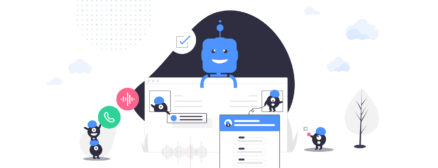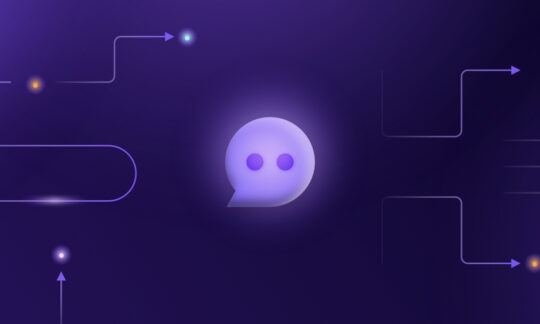Training an AI Chatbot – A Step-By-Step Guide
Table of contents
- Why Chatbot Training Is so Important in Conversational AI
- Common Terms Used in Chatbot Training
- Training and Optimising Your Chatbot’s NLU Engine
- Training Your Chatbot for Quality Conversations
- Accelerate and Improve Chatbot Testing
- Enabling Multilingual Capabilities for Your Chatbot
- Speeding Things Up Using ChatGPT to Train Chatbots
- Stay Connected for More Bot-Building Advice
- Article Summary
Welcome to another instalment of our Bot Building Series. For this article, we’ll assume you understand the basics of chatbots and conversational AI. However, if you’re new to the bot design field – don’t worry. Go back to our introductory content where we explain in detail what chatbots are, and how to create and design them.
Whether you’re a beginner or an experienced bot designer, the good news is you don’t need a PhD in Computer Science or Data Engineering to build a highly effective chatbot for your business. With the right tools, datasets, and a willingness to learn, your bot will be up and running in no time. Today, we’ll focus on a process that is arguably the most important factor in the quality of conversations your chatbot can have – training.
Why Chatbot Training Is so Important in Conversational AI
There are many chatbot providers out there promoting pre-trained, plug-and-play chatbots that can be integrated into your website interface with just a few lines of code. With those out-of-the-box capabilities, what’s all the fuss about AI training?
To answer this, consider the offline options for customer support that your business offers today, such as phone support. Now consider the proportion of these calls that involve specific aspects of that customer’s profile as it relates to your company’s products or services. For most businesses, this proportion is extremely high, and successful resolution requires chatbot training.
Training is all about enabling your chatbot to effectively serve the specific needs of your business and your customers. It enables your bot to answer customer queries that no out-of-the-box chatbot experience can provide. Such a query in a banking scenario might be, “Why was my platinum card charged interest last month?” To create a satisfying support experience for this type of query and customer, chatbot training is essential.
Common Terms Used in Chatbot Training
Before we get too deep into training a chatbot for useful conversations, let’s ensure we’re speaking the same language. Here are some of the more common terms associated with chatbot and NLU model training:
- Utterances/phrases: These are the questions or statements that a chatbot receives from a user or a tester. When training your chatbot, you’ll likely compile a long list of utterances/phrases that cover the specifics of your business and industry. This list helps train the chatbot to understand the many different ways a user can make a request.
- Intent: Intent represents the underlying need or goal of a phrase. One customer might engage a hotel chain chatbot, saying “I’d like to book a room”, while another might say “I left a book in my room.” If the chatbot recognises intent effectively, one client will receive responses to help them book their stay, while the other will be routed to a process for lost & found items. A chatbot’s ability to accurately discern what a user wants (intent detection) generates an important metric for bot trainers to monitor (intent recognition accuracy).
- Entities are informative pieces of data contained in phrases. Entities are often nouns, such as a product or service, an object, or a time or place. Chatbots are trained to extract and interpret entities. Entities can also have variables attached to them; for example, “vehicle” might be associated with “car”, “van”, “truck”, etc. We can further break down entities by type:
– Most chatbot platforms come with several built-in entities, such as surname, email, etc.
– Keyword entities are used by professionals who train AI to store synonyms and variations of terms.
– Regex entities are used to recognise regular patterns, such as email addresses, phone numbers, or booking reference numbers.
– Pattern entities differentiate more complex or less frequently used expressions.
- NLU engine: While related to Natural Language Processing (NLP), Natural Language Understanding (NLU) is a different field of AI research. NLU involves enabling computer systems to process and interpret human language. An NLU engine or NLU model, such as SentiOne’s advanced NLU model, is an NLU system with existing algorithms, prior training with datasets, and tools for customisation and configuration.
Training and Optimising Your Chatbot’s NLU Engine
There are two main aspects of training a chatbot: training the NLU for your bot, and then training your bot.
First, let’s cover training the NLU. In this step you’ll essentially enhance the vocabulary of your bot, training it with chatbot training data that includes the utterances and entities used to describe your business, products, and industry. Broadening the language capabilities of your bot enables it to more accurately understand user intent and respond to customer needs.
If you’ve ever had a frustrating chatbot experience resulting in the response, “I’m sorry. I don’t understand what you’re asking for”, it’s because the bot’s training dataset didn’t include the question you asked, and therefore it failed to recognise your intent.
To avoid this type of experience, and achieve high intent-recognition accuracy, you need high-quality variations of sentences and queries that your customers are likely to use. It all revolves around the volume, quantity, and relevancy of the data you provide your bot. The most effective conversational AI bots are fed large volumes of data into their NLU engine; AI learning and ML models work best with rich source material to synthesise. This includes diverse datasets that can include text from social listening, client data your business owns, call centre transcripts, or historical conversations from digital channels such as Messenger, Twitter, or emails.
Gathering this much data from across your organisation may be simple, or incredibly challenging. It will depend on your organisation’s data enablement, data strategy, and possibly the support of a few gatekeepers. If your barriers seem huge, don’t despair. Some chatbot platforms make NLU training easier. SentiOne has datasets from 11 years of social media monitoring, which help improve the precision of SentiOne’s state-of-the-art intent detection model. With 150 million new data points added to the SentiOne’s award-winning NLU engine every day, SentiOne achieves intent recognition accuracy ranging from 94-96%. This means that just 4-6% of chatbot queries are not correctly understood. That’s a high benchmark. For most bot-building teams, 80-85% intent recognition accuracy can deliver excellent business results.
High intent recognition accuracy is achieved when bots understand synonyms, spoken language, and the industry-based nuances of how actual customers speak. It is important to layer in as much company and customer-specific data as you can. The effort is made easier by the wealth of NLU training that some platforms offer.
Training Your Chatbot for Quality Conversations
All of the preceding work involved enabling the NLU engine to understand queries and associate them with the right intent. At this point you’ve designed a bot, mapped conversation flows, integrated company systems, and …. you finally have a bot you can talk to and test! The next aspect of training is TRAINING your bot to improve conversational performance and ability to resolve customer issues successfully. Now you need to assess:
- Is it recognising questions?
- Is it replying properly to questions?
- Is it giving correct answers?
This stage involves refining responses, and adding more as any gaps are discovered. You want to leverage all of your insight into existing customer support needs and walk in the client’s shoes to interact with the chatbot as a live customer would. Once your bot is live and collecting analytics, you’ll want to reiterate similar cycles of refinement to continue to improve business KPIs. An important metric for many teams is the bot’s ability to successfully close service issues without escalating the chat to a human representative.
Before you sit down with a list of 1,000 customer chatbot queries and get to work, let’s talk about options for automated chatbot testing.
Accelerate and Improve Chatbot Testing
Done the manual way, chatbot testing is highly manual, tedious, and extremely time-consuming.
Some platforms like SentiOne Automate include automated bot tests that can engage the bot in conversations and test the quality of responses. Automated testing can run 1,000s of conversations through the system and drastically reduce manual effort. Testing teams can then spend more time improving results rather than inputting queries.
As part of the testing effort, it’s often helpful to share the bot with others outside of the project team. With a fresh perspective, they can help look for “corner cases”, bot behaviours not factored into the current testing plan. For example, how does the bot react when you swear or ask controversial questions? How does it handle a long, silent pause? Are there common slang phrases or small-talk expressions the team has missed?
Enabling Multilingual Capabilities for Your Chatbot
Many chatbots are capable of speaking different languages, and they can automatically infer probable language preferences based on the browser’s default language or the location of an IP address.
Chatbots like SentiOne Automate can also speak multiple languages within the same conversation. Users can ask a question in Spanish, and then another in German, and the chatbot will understand both and reply in the respective language. Frequent travellers can enjoy the instant utility of chatbots without having to translate or select their language choice as they do on websites and with phone support. Regardless of location they can instantly interact in their preferred language.
SentiOne Automate has a pre-trained multi-language NLU that makes this job easier. Teams can train their bot using their preferred language, and SentiOne will use that same training model to offer responses in virtually any languages you choose to enable. If your company mainly interacts in 2-3 specific languages, you can bring in multilingual team members to further customise and optimise the language training, but there is no need to sequentially train your bot language by language.
Speeding Things Up Using ChatGPT to Train Chatbots
While they don’t offer the same customer support features as conversational AI chatbots, chatbots that leverage large language models (most notably, ChatGPT) can help speed some of the tasks involved in training conversational AI chatbots. They offer the ability to associate and synthesise language in ways that can be quite useful. Some potential use cases include:
- Building NLU using dataset examples: You can take a common customer phrase such as “I’d like to request a refund” and ask ChatGPT for examples of similar phrases.
- Generating synonyms of entities: ChatGPT can quickly generate a list of synonyms for common words your customers might use.
- Create user journeys or flows: You can ask ChatGPT to generate scenarios or flows for common tasks, such as finding your company’s local branch office.
- Building test scripts: ChatGPT can help with testing. Enter a common customer need (e.g. checking account balance) and ask ChatGPT to generate 10 different ways of phrasing it.
- Creating bot responses: ChatGPT can help with creating text for the answers provided by your chatbot.
The latest release of SentiOne Automate integrates OpenAI’s ChatGPT to allow for automatic generation of phrases in NLU. Bear in mind that these types of use cases are still somewhat in the experimental phase – always check accuracy and appropriateness of any ChatGPT text!
Stay Connected for More Bot-Building Advice
Hopefully the guidance and AI tips in this article can help you train your chatbot to a high degree of success. Continue your learning journey through our Bot Building series – next, we’re going to tell you all about choosing the best communication channel for your chatbot.
The team behind the SentiOne Automate platform has deep experience in natural language understanding and conversational AI. If you’d like to discover more about AI-based chatbots, book a demo with our team of experts.
Please note that when discussing chatbots, we also mean voice bots. The primary distinction between them is the mode of communication, but they share the same underlying technology, with the addition of voice-specific technologies. Consequently, both solutions have similar use cases. Therefore, the principles discussed in the Bot Building Series can be applied to both chatbots and voice bots without any significant differences.
Article Summary
The article is part of our Bot Building Series and emphasises the importance of chatbot training in conversational AI. It discusses the significance of training chatbots to effectively serve specific business and customer needs, enabling them to provide accurate and satisfying responses. The article explains key terms related to chatbot training, such as utterances, intent, entities, and NLU engine. It highlights the process of training the NLU engine and training the chatbot itself to improve conversational performance and resolution of customer issues. The article also mentions the benefits of automated chatbot testing and the ability of chatbots to support multilingual capabilities. Additionally, it introduces the use of large language models like ChatGPT to assist in training chatbots by generating examples, synonyms, user journeys, test scripts, and bot responses.



